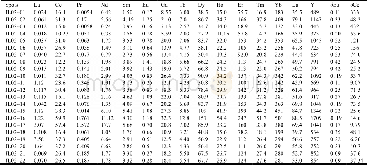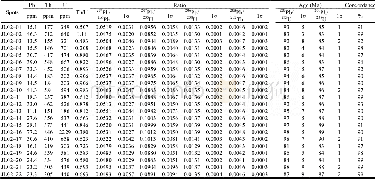《Table 5 LA–ICP–MS Zircon Lu–Hf Isotope Compositions of the Granitoids in Jiangla’angzong》
 提示:宽带有限、当前游客访问压缩模式
提示:宽带有限、当前游客访问压缩模式
本系列图表出处文件名:随高清版一同展现
《"Petrogenesis of Late Cretaceous Jiangla'angzong I-Type Granite in Central Lhasa Terrane, Tibet, China: Constraints from Whole-Rock Geochemistry, Zircon U-Pb Geochronology, and Sr-Nd-Pb-Hf Isotopes"》
Notes:εHf(0)=( (176Hf/177Hf)/(176Hf/177Hf)CHUR,0-1) ×10000;εHf(t)=( (176Hf/177Hf)-(176Lu/177Hf)×(eλt-1)) /( (176Hf/177Hf)CHUR,0-(176Lu/177Hf)CHUR×(eλt-1)) -1) ×10000;(176Hf/177Hf)t=(176Hf/177Hf)-(176Lu/177Hf)×(eλt-1)
Classical granite classification states that granites can be divided into A-type(non-orogenic),S-type(derived from sedimentary protoliths),I-type(extracted from igneous protoliths),and M-type(derived directly from the melting of subducted oceanic crust or overlying mantle)granites(Whalen,et al.,1987).Highly differentiated I-type,S-type,M-type,and A-type granites have similar geochemical and mineralogical characteristics,with mineral components and chemical compositions similar to granite crystalized near a eutectic point after high-degree fractional crystallization,are always difficultlydistinguished(Chappell,et al.,1988,Wu Fuyuan et al.,2007).Thus,to accurately distinguish genetic types,we need to determine whether these granites have experienced high-degree fractional crystallization(Chappell,et al.,1992).In the Fe OT/Mg O-Ga/Al discrimination diagram(Fig.7a),samples of Jiangla’angzong syenogranite and adamellite are plotted within the scope of I-type,S-type,and M-type granites,far away from the A-type and highly differentiated type granites,thus belonging to a subset of granites showing a lower degree of differentiation(DI:75.0–85.5).The Jiangla’angzong samples include hornblende,pyroxene,and other accessory minerals,have no muscovite,cordierite,garnet,or other aluminous minerals,and have A/CNK values of 0.88–1.02,indicating that they are metaluminous granites(Fig.3c).The plots in the ACF diagram(Fig.7f)are far from aluminiferous minerals such as muscovite,cordierite,and garnet,and fall within the scope of I-type granites,indicating that the granite was formed by a syntexis of crustal and mantle materials.Na,Ca,and Sr in S-type granite sources are lost during the weathering process of feldspars,becomingclays that make the granite peraluminous(not due to an increase in Al).Thus the Na,Ca,and Sr contents are obviously lower than in I-type granites.The Na2O content(2.91–3.73wt%),Ca O content(2.33–4.11wt%),and Sr content(163–312 ppm)of Jiangla'angzong granites are all significantly higher than those of typical Early Cretaceous(122±1 Ma)Qingcaoshan S-type granites(Na2O content:1.77–4.14wt%;Ca O content:1.10–2.44wt%;Sr content:11.6–26.2ppm)(Liu Hong et al.,2016) .During the magmatic differentiation process ranging from metaluminous to weakly peraluminous,apatite decreases with the increase of Si O2,whereas apatite behaves oppositely in strongly peraluminous magma(Wolf,et al.,1994).This characteristic has been successfully used to distinguish I-type and S-type granitoids(Li et al.,2003a,2003b;Chappell,et al.,1999;Wu et al.,2003).For Jiangla'angzong granites,P2O5 contents decrease with rising Si O2 content,which is consistent with I-type granite evolution(Fig.7e,Chappell,et al.,1992).The positive correlation between Pb and Si O2 also indicates an I-type granite evolution trend,which is also supported by relatedtrends in Th,Y,and Rb content(Figs.7b,7c).Early in peraluminous magma evolution,Th and Y preferentially enter minerals such as monazite that are enriched in Th and Y.Thus,the S-type granites have low Th and Ycontents that decrease as Rb content increases,which is contrary to the I-type granite evolution trend(Li et al.,2003a,2013b).The Th,Y and Rb contents of Jiangla'angzong granites clearly display an I-type granite evolution trend.In addition,the bulk zirconium saturation temperatures calculated above for Jiangla’angzong rocks(Table 1,794°C–819°C)is obviously higher than that of the average S-type granite temperature(764°C,Pearce et al.,1984).The above evidence demonstrates that the Jiangla’angzong granite is a metaluminous,highpotassium calc-alkaline I-type granite related to the syntexis of crustal and mantle materials.
| 图表编号 | XD0017176600 严禁用于非法目的 |
|---|---|
| 绘制时间 | 2018.08.01 |
| 作者 | LIU Hong、LI Guangming、HUANG Hanxiao、CAO Huawen、YUAN Qian、LI Yingxu、OUYANG Yuan、LAN Shuangshuang、Lü Menghong、YAN Guoqiang |
| 绘制单位 | Chengdu Center,China Geological Survey、Chengdu Center,China Geological Survey、Chengdu Center,China Geological Survey、Chengdu Center,China Geological Survey、Faculty of Earth Resources, China University of Geosciences、Chengdu Center,China Geological Survey、 |
| 更多格式 | 高清、无水印(增值服务) |
查看“Table 5 LA–ICP–MS Zircon Lu–Hf Isotope Compositions of the Granitoids in Jiangla’angzong”的人还看了
-

- Table 3 Representative zircon Lu–Hf isotope data of the Daga granite pluton in the Quxu region, southern Tibet
-

- Table 3 Zircon Lu-Hf isotopic compositions of olivine websterite in the No.I mafic-ultramafic complex





